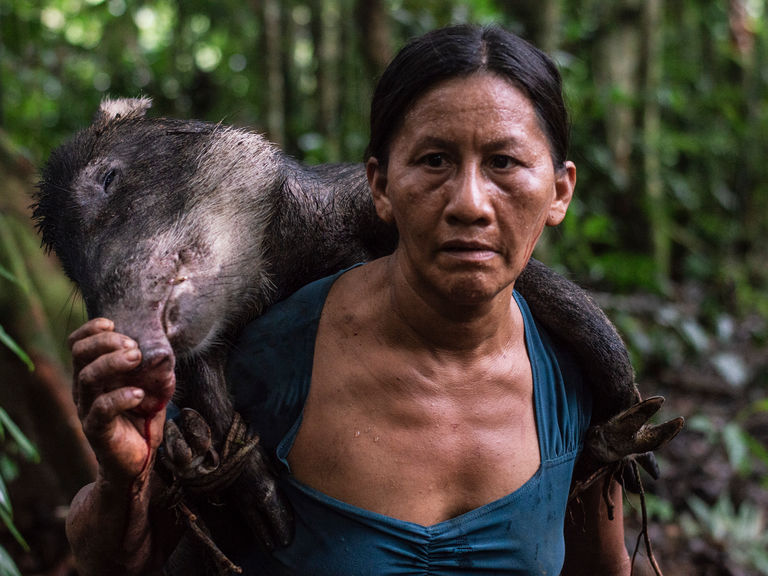Project Detail: HUMAN FOREST
Contest:
Reportage and Documentary 2020
Brand:
LuganoPhotoDays
Author:
Marina Tana
Project Info
HUMAN FOREST
The Amazon is "the green lung of the Earth" for everyone. Few consider the fact that it is a place inextricably connected with human beings who have lived there for centuries, direct witnesses of its uniqueness and of the ongoing social and environmental upheavals. First presented to the world in 1956 by LIFE, after the tragic contact attempt covered by Cornell Capa, then invasively "civilized" in the sixties and seventies, today the Waorani survive suspended between an ancestral lifestyle of communion with the forest, now compromised, and a predatory modernity. Through the encounter with the Waorani community of Bameno in the heart of the Amazon forest in Ecuador, Human Forest centers on people, wanting to overcome classic stereotypes about indigenous peoples and focusing on the inseparable bond between human beings and the forest. An invitation to reflect on the sense of limit and the human condition. “Waorani means Humans. It is from here that I believe we should all start again”
The Amazon rainforest is not only "the green lung of the Earth", a region covering an area of approximately 7 million sq. km between Brazil, Colombia, Peru, and six other nations, and which is home to the most extraordinary biodiversity in the world – one-tenth of the existing plant and animal species. The Amazon rainforest is inextricably connected with the human beings who have always lived there and are part of its richness. However, we rarely return the due importance and essential role to populations that have lived, understood and defended the forest for centuries. This photographic story is dedicated to them, through my experience at the Waorani indigenous community of Bameno, Ecuador.
The community of Bameno, reachable with a difficult, nearly two-day trip in a motorized canoe, exists in the heart of the Amazonian forest of Ecuador, in the Zòna Intangible of the Yasuní National Park, created in 1999 to protect the Waorani territory and the indigenous groups that live there - including the Tagaeri and the Taromenani, who have chosen to live in voluntary isolation. The area is representative of the tenuous border existing between the policies to defend the ancestral human, natural and cultural heritage of the forest, and the enormous economic interests behind the bloques, the concessions for oil exploitation that surround and threaten it.
The Waorani are a legendary tribe of warriors and great hunters, feared and respected by other indigenous peoples for their strength, temerity and knowledge of the forest. First presented to the world in 1956 as "the worst people on Earth" by Life Magazine, after the tragic contact attempt covered by the reporter Cornell Capa, then invasively "civilized" and evangelized between the sixties and seventies, they underwent in the arc of only two generations a very strong social and cultural metamorphosis. Today, the Waorani survive suspended between an ancestral lifestyle of communion with the forest, now compromised, and predatory modernity, in an indifferent world.
During my stay alone for four weeks in the village of Bameno, I witnessed daily life in the Amazon rainforest and managed to see beyond the spectacularization and commodification of the traditions for "community based" tourism, the difficulties that this indigenous community experiences daily, in their commitment to preserve the memory of their ancestral customs and to counter the environmental threat, corruption and seduction of the West.
On the occasion of the Coronavirus pandemic, Brazilian photographer Sebastião Salgado launched an appeal in defense of the Amazonian peoples. The photographer writes with concern: “Without any protection against this highly contagious virus, indigenous peoples face a real risk of genocide” due to contamination caused by uncontrolled entries into their lands and practically non-existent access to health facilities.
The Waorani of Bameno, the first true guardians of the forest, today ask the cowode (foreigners) to be left free to live their life, in communion with the forest, Ome in the Wao language, which also means “world”. Deje vivir! (Let us live!) is the appeal of Penti Baihua, the community leader.
The history and future of the Amazon rainforest and the people who live there arouses a stark awareness of a world, not only the Amazonian one, which is inexorably crumbling away in the inability to recover the profound sense of the limit and the human condition.
Waorani means "Humans". It is from here that I believe we should all start again.


















